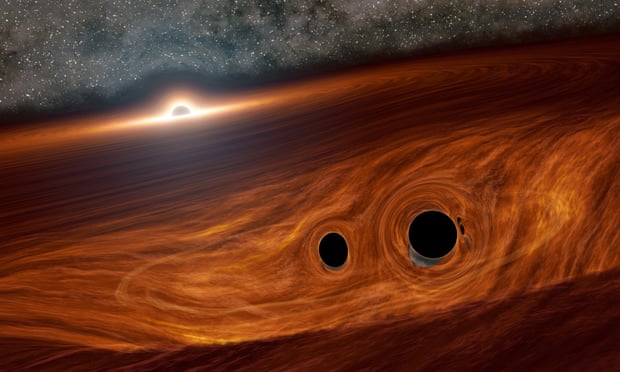
It doesn’t get any blacker than a black hole, the densest object in the universe. Their gravitational pull is so strong that nothing can escape its clutches, including light.
However, it’s an ironic twist of fate that when two black holes merge in a cataclysmic event, they can also produce a flare of light as powerful as a trillion suns. Astronomers have now confirmed this phenomenon for the first time in a new study.
On May 21, 2019, scientists affiliated with the National Science Foundation’s Laser Interferometer Gravitational-wave Observatory (LIGO) and the European Virgo detected the gravitational waves generated by the merger of two black holes, in an event dubbed S190521g.
Gravitational waves are essentially ripples in the fabric of spacetime which are generated by interactions between very massive accelerating cosmic objects, such as neutron stars or black holes. Physicists liken gravity waves to the waves generated by a stone thrown into a pond.
Although gravitational waves were predicted by Einstein’s Theory of Relativity, their existence was confirmed very recently in 2016 by LIGO, whose founders were awarded the much deserved Nobel Prize in Physics one year later.
Since then, scientists have found many sequences of gravitational waves, with much more to follow once more sensible detectors come online.
This story isn’t about gravitaional waves, though. While studying S190521g, physicists at Caltech’s Zwicky Transient Facility (ZTF) also spotted a flare of light emanting from the pair of merging black holes.
“This supermassive black hole was burbling along for years before this more abrupt flare,” Matthew Graham, a research professor of astronomy at Caltech and the project scientist for ZTF, said in a statement. “The flare occurred on the right timescale, and in the right location, to be coincident with the gravitational-wave event.”
Light-emitting black holes mergers aren’t exactly a new idea. They’ve been theorized before by physicists whose models suggested that merging black holes can plow into the hot gas, dust, and all the other jumbled mess of matter hovering around the black hole, waiting to be gobbled up.
The huge momentum and sudden release of kinetic energy of the merged black hole can cause gas to react, generating a bright flare.
Now, the theory has been shown to also work in practice. The light from S190521g was visible for days, before it slowly faded into oblivion about a month later.
However, the researchers say they will keep an eye on this newly birthed supermassive black hole. They hope to catch another flare within a couple of years as it is expected to ram into the surrounding disk of gas once more.
“Supermassive black holes like this one have flares all the time. They are not quiet objects, but the timing, size, and location of this flare was spectacular,” Mansi Kasliwal, an assistant professor of astronomy at Caltech, and co-author of the study, said in a statement.
“The reason looking for flares like this is so important is that it helps enormously with astrophysics and cosmology questions. If we can do this again and detect light from the mergers of other black holes, then we can nail down the homes of these black holes and learn more about their origins.”
The findings appeared in the journal Physical Review Letters.
Was this helpful?



